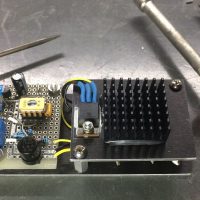The Keck domes can be controlled three ways… From a set of manual controls on a panel at the base of the dome, via computer control when observing, and from a radio controller that you can use from anyplace in the dome. This radio controller has long been called Capt. Marvel around Keck, the original versions looked like a prop from a 1930’s sci-fi serial movie.

The unit is standard, the panel is custom. When buying the transmitter you need to specify the front panel layout including the switches and labels for your application. Thus our transmitter has a panel arranged to our specification with switches for dome rotation and opening the shutters. In the middle is a bright red-emergency stop switch to insure you can immediately stop everything if something goes wrong.

